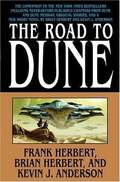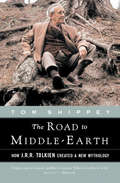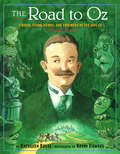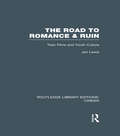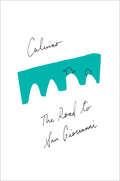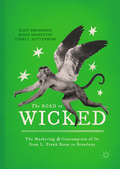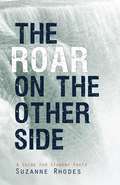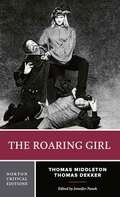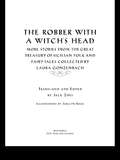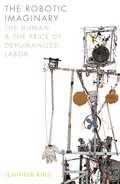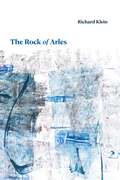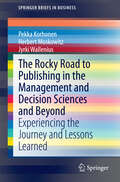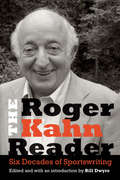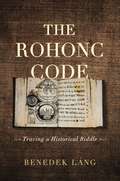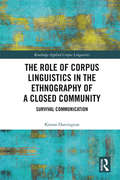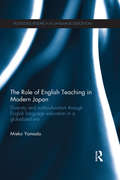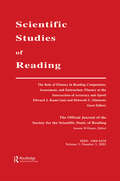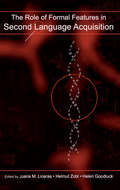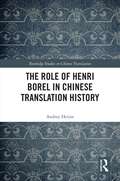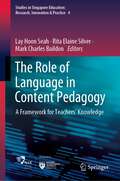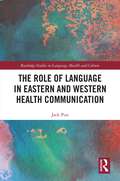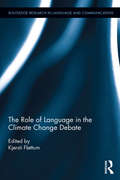- Table View
- List View
The Road to Dune
by Kevin J. Anderson Frank Herbert Brian HerbertDune is perhaps the most popular sf series created in the last fifty years. Now, for the first time, readers can see into the mind of the author as he writes about and writes Dune. His son and Kevin J. Anderson provide a novel based on an original design of Dune that never happened and provide several short stories and introductory notes before each new section.
The Road to Middle-Earth: How J. R. R. Tolkien Created a New Mythology
by Tom Shippey&“Uniquely qualified to explicate Tolkien&’s worldview,&” this journey into the roots of the Lord of the Rings is a classic in its own right (Salon.com).From beloved epic fantasy classic to record-breaking cinematic success, J.R.R. Tolkien's story of four brave hobbits has enraptured the hearts and minds of generations. Now, readers can go deeper into this enchanting lore with a revised edition of Tom Shippey's classic exploration of Middle-earth. From meditations on Tolkien's inspiration to analyses of the influences of his professional background, The Road to Middle-earth takes a closer look at the novels that made Tolkien a legend. Shippey also illuminates Tolkien's more difficult works set in the same world, including The Silmarillion, Unfinished Tales, and the myth cycle, and examines the remarkable twelve-volume History of Middle-earth, written by J.R.R.'s son Christopher Tolkien. At once a celebration of a beloved classic and a revealing literary study, The Road to Middle-earth is required reading for fantasy fans and English literature scholars alike.
The Road to Oz: Twists, Turns, Bumps, and Triumphs in the Life of L. Frank Baum
by Kathleen Krull Illustrated by Kevin HawkesKATHLEEN KRULL’S LIVELY text traces the life of L. Frank Baum from his dreamy privileged childhood in mid-19th-century upstate New York through the many detours on his road to Oz. A failure as an actor, a breeder of prize chickens, a merchant in a wild west town, among other occupations, he finally made a success doing exactly what he had always loved to do: tell stories for children. Along the way, we see the antecedents of the Scarecrow, the Tin Man, green glasses, and other characters and attributes of the famous fantasy land. This is the first biography of L. Frank Baum that children can enjoy. With the same verve she brought to her biography of Dr. Seuss, Kathleen Krull’s wry prose couples with Kevin Hawke’s exuberant paintings and drawings to create a book not to be missed by Oz fans of all ages.
The Road to Romance and Ruin: Teen Films and Youth Culture (Routledge Library Editions: Cinema)
by Jon LewisThis book analyses the teen film as the rare medium able to represent the otherwise chaotic and conflicting experience of youth. The author focuses on six major issues: alienation, deviance and delinquency, sex and gender, the politics of consumption, the apolitics of youth(ful) rebellion, and regression into nostalgia. Despite the many differences within the genre, this book sees all teen films as focused on a single social concern: the breakdown of traditional forms of authority – school, church, family. Working with the theories of such diverse scholars as Kenneth Keniston, Bruno Bettelheim, Erik Erikson, Theodor Adorno, Simon Frith, and Dick Hebdige, the author draws an innovative and flexible model of a cultural history of youth. Originally published in 1992.
The Road to San Giovanni
by Italo CalvinoFrom the Italian author, personal essays featuring his relationship with his father, his love of movies, and fighting fascism during World War II. &“In each other&’s presence we became mute, would walk in silence side by side along the road to San Giovanni. To my father&’s mind, words must serve as confirmations of things, and as signs of possession; to mine, they were foretastes of things barely glimpsed, not possessed, presumed.&” —from The Road to San Giovanni In these autobiographical essays, published after Italo Calvino&’s death, the intellectually vibrant writer not only reflects on his own past but also inquires into the very workings of memory itself. From the title essay&’s lyrical evocation of the author&’s relationship with his father, and a charming account of teenage years spent in the glow of the cinema screen, to Calvino&’s reminiscences of his experiences in the Italian Resistance during World War II and of his years in Paris, to his declaration of purpose as a writer in the final essay&’s visionary fragments, these five &“memory exercises&” are heartfelt, affecting, and wise.Praise for The Road to San Giovanni&“Brimming with Calvino&’s beautifully crafted prose, dry humor, and continual questioning . . . Calvino has been very well served by his translator, Tim Parks.&” —Observer&“In five elegant &“memory exercises&” written between 1962 and 1977, Italian fiction writer Calvino (1923-85) presents an affecting self-portrait and offers indirect insights into how he conjured up his imaginary worlds . . . . This sparkling translation concludes with Calvino's lyric, metaphorical, highly elliptical description of his creative process.&” —Publishers Weekly
The Road to Wicked: The Marketing and Consumption of Oz from L. Frank Baum to Broadway
by Susan Aronstein Kent Drummond Terri L. RittenburgThe Road to Wicked examines the long life of the Oz myth. It is both a study in cultural sustainability— the capacity of artists, narratives, art forms, and genres to remain viable over time—and an examination of the marketing machinery and consumption patterns that make such sustainability possible. Drawing on the fields of macromarketing, consumer behavior, literary and cultural studies, and theories of adaption and remediation, the authors examine key adaptations and extensions of Baum’s 1900 novel. These include the original Oz craze, the MGM film and its television afterlife, Wicked and its extensions, and Oz the Great and Powerful—Disney’s recent (and highly lucrative) venture that builds on the considerable success of Wicked. At the end of the book, the authors offer a foundational framework for a new theory of cultural sustainability and propose a set of explanatory conditions under which any artistic experience might achieve it.
The Road to Wigan Pier
by George OrwellIn the 1930s Orwell was sent by a socialist book club to investigate the appalling mass unemployment in the industrial north of England. He went beyond his assignment to investigate the employed as well-"to see the most typical section of the English working class." Foreword by Victor Gollancz.
The Roar On The Other Side: A Guide For Student Poets
by Suzanne U. ClarkFor all its storied past and lofty reputation, poetry is really just the art of noticing, naming, and comparing the stuff of this world. Unlike the eye of modern science (which sees the world as a giant specimen for us to dissect), poetry fosters and nurtures life by finding wonder in the nooks and crannies of ordinary life. Suzanne U. Clark, a longtime poet and teacher, offers The Roar on the Other Side as an introductory guide for students (junior high and up). Clear and imaginative, this book makes poetry approachable. Students will emerge from this book with a good handle on the basics of writing poetry and a new appreciation for the awesome world in which we live.
The Roaring Girl: A Norton Critical Edition (Norton Critical Editions)
by Thomas Dekker Thomas MiddletonThis Norton Critical Edition of Thomas Middleton and Thomas Dekker’s The Roaring Girl is based on the text from English Renaissance Drama: A Norton Anthology. It is accompanied by generous explanatory annotations, five illustrations, and a detailed introduction. “Contexts” is thematically arranged to include almost all known documents from the period concerning Mary Frith (aka Moll Cutpurse), among them records of her court appearances, letters recounting the same, and her last will. Also reprinted are significant passages from her purported 1662 “autobiography,” The Life and Death of Mrs. Mary Frith. While of dubious veracity, the “autobiography” is useful for comparing the play’s portrayal of Moll with later developments in Moll Cutpurse lore, which the Norton Critical Edition traces through the eighteenth and nineteenth centuries. Perhaps most engaging for classroom discussion are substantial excerpts from the 1620 cross-dressing pamphlets―Hic Mulier; or, The Man-Woman and Haec Vir; or, The Womanish Man―which appear in annotated, modern-spelling versions. Together they give insight into how gender-bending trends in clothing, similar to those practiced by Moll, were understood in the early seventeenth century. A related passage from A Sermon of Apparel adds another perspective on cross-dressing practices. Fourteen critical essays chart the development of scholarly interest in The Roaring Girl, from the first half of the twentieth century, when the play received only passing reference, through the work on city comedy in the 1970s and 1980s, to the explosion of analyses in the late 1980s and 1990s, when the play became a major focus for early modern gender studies. The more recent critical essays move beyond a strict focus on gender and cross-dressing to explore The Roaring Girl’s depiction of other aspects of early modern London, including consumer culture and the contemporary fascination with the language of the criminal underworld. Contributors include, among others, T. S. Eliot, Alexander Leggatt, Mary Beth Rose, Jonathan Dollimore, Jean E. Howard, and Jonathan Gil Harris. A Selected Bibliography is also included.
The Robber with a Witch's Head: More Stories from the Great Treasury of Sicilian Folk and Fairy Tales Collected by Laura Gonzenbach
by Jack Zipes Laura GonzenbachThe Robber with the Witch's Head presents almost fifty new stories about demons and clever maidens and princes. Bursting with life, this is a storyteller's dream, full of adventure and magic, translated by Jack Zipes.
The Robotic Imaginary: The Human and the Price of Dehumanized Labor
by Jennifer RheeTracing the connections between human-like robots and AI at the site of dehumanization and exploited labor The word robot—introduced in Karel Čapek&’s 1920 play R.U.R.—derives from rabota, the Czech word for servitude or forced labor. A century later, the play&’s dystopian themes of dehumanization and exploited labor are being played out in factories, workplaces, and battlefields. In The Robotic Imaginary, Jennifer Rhee traces the provocative and productive connections of contemporary robots in technology, film, art, and literature. Centered around the twinned processes of anthropomorphization and dehumanization, she analyzes the coevolution of cultural and technological robots and artificial intelligence, arguing that it is through the conceptualization of the human and, more important, the dehumanized that these multiple spheres affect and transform each other.Drawing on the writings of Alan Turing, Sara Ahmed, and Arlie Russell Hochschild; such films and novels as Her and The Stepford Wives; technologies like Kismet (the pioneering &“emotional robot&”); and contemporary drone art, this book explores anthropomorphic paradigms in robot design and imagery in ways that often challenge the very grounds on which those paradigms operate in robotics labs and industry. From disembodied, conversational AI and its entanglement with care labor; embodied mobile robots as they intersect with domestic labor; emotional robots impacting affective labor; and armed military drones and artistic responses to drone warfare, The Robotic Imaginary ultimately reveals how the human is made knowable through the design of and discourse on humanoid robots that are, paradoxically, dehumanized.
The Rock of Arles
by Richard KleinFounded 2,600 years ago on a massive limestone eminence, the city of Arles has been the home of Roman emperors and captured slaves, pagan temples and Christian spires, bloody revolutionaries and powerful papists. In The Rock of Arles Richard Klein relays the history of the city as told to him by the Rock, its genius loci, which infallibly remembers every moment of its existence, from the Roman conquest of Gaul to the fall of feudal aristocracy, from the domination of the Catholic Church to the present French representative democracy. The Rock’s contrarian and dissident history resurrects the memory of three of the city’s most radical yet largely forgotten revolutionary minds: Hellenistic philosopher Favorinus, medieval Hebrew poet Kalonymus ben Kalonymus, and subversive aristocrat Pierre-Antoine Antonelle. For the Rock, each figure represents a freethinking current running through Arlesian history which countered the reactionary, bigoted forces that governed the city for fifteen centuries. Erudite, witty, and opinionated, the Rock tells the story of Arles in order to sketch the broader canvas of European history while invoking the city’s possible future.
The Rocky Road to Publishing in the Management and Decision Sciences and Beyond
by Jyrki Wallenius Pekka Korhonen Herbert MoskowitzThis book documents the history of two research papers, from the first drafts to the final polished published articles, including the reviewer comments and the author responses. The documentary provides unique insights into the publishing process, which at times is filled with uncertainties, not only for young researchers. The book discusses lessons learned and also provides an experienced editor's and reviewer's perspective. In the light of the high pressure on young faculty to publish successfully, this book offers itself as a guide to publishing efficiently and effectively in a highly competitive scientific environment.
The Roger Kahn Reader: Six Decades of Sportswriting
by Roger Kahn Bill DwyreMost famous for his classic work The Boys of Summer, Roger Kahn is widely regarded as one of the greatest sportswriters of our time. The Roger Kahn Reader is a rich collection of his stories and articles that originally appeared in publications such as Sports Illustrated, theNew York Times, Esquire, and the Nation. Kahn’s pieces, published between 1952 and today, present a vivid, turbulent, and intimate picture of more than half a century in American sport. His standout writings bring us close to entrepreneurs and hustlers (Walter O'Malley and Don King), athletes of Olympian gifts (Ted Williams, Stan Musial, “Le Demon Blond” Guy Lefleur), and sundry compelling issues of money, muscle, and myth. We witness Roger Maris’s ordeal by fame; Bob Gibson’s blazing competitive fire; and Red Smith, now white-haired and renowned, contemplating his beginnings and his future. Also included is a new and original chapter, “Clem,” about the author’s compelling lifelong friendship with former Brooklyn Dodgers pitcher Clem Labine. Written across six decades, this volume shows Kahn’s ability to describe the athletes he profiled as they truly were in a manner neither compromised nor cruel but always authentic and up close.
The Rohonc Code: Tracing a Historical Riddle
by Benedek LángFirst discovered in a Hungarian library in 1838, the Rohonc Codex keeps privileged company with some of the most famous unsolved writing systems in the world, notably the Voynich manuscript, the Phaistos Disk, and Linear A. Written entirely in cipher, this 400-year-old, 450-page-long, richly illustrated manuscript initially gained considerable attention but was later dismissed as an apparent forgery. No serious scholar would study it again until the turn of the twenty-first century. This engaging narrative follows historian Benedek Láng’s search to uncover the truth about this thoroughly mysterious book that has puzzled dozens of codebreakers. Láng surveys the fascinating theories associated with the Codex and discusses possible interpretations of the manuscript as a biblical commentary, an apocryphal gospel, or a secret book written for and by a sect. He provides an overview of the secret writing systems known in early modern times and an account of the numerous efforts to create an artificial language or to find a long-lost perfect tongue—endeavors that were especially popular at the time the Codex was made. Lastly, he tests several codebreaking methods in order to decipher the Codex, finally pointing to a possible solution to the enigma of its content and language system.Engagingly written, academically grounded, and thoroughly compelling, The Rohonc Code will appeal to historians, scholars, and lay readers interested in mysteries, codes, and ciphers.
The Rohonc Code: Tracing a Historical Riddle
by Benedek LángFirst discovered in a Hungarian library in 1838, the Rohonc Codex keeps privileged company with some of the most famous unsolved writing systems in the world, notably the Voynich manuscript, the Phaistos Disk, and Linear A. Written entirely in cipher, this 400-year-old, 450-page-long, richly illustrated manuscript initially gained considerable attention but was later dismissed as an apparent forgery. No serious scholar would study it again until the turn of the twenty-first century. This engaging narrative follows historian Benedek Láng’s search to uncover the truth about this thoroughly mysterious book that has puzzled dozens of codebreakers. Láng surveys the fascinating theories associated with the Codex and discusses possible interpretations of the manuscript as a biblical commentary, an apocryphal gospel, or a secret book written for and by a sect. He provides an overview of the secret writing systems known in early modern times and an account of the numerous efforts to create an artificial language or to find a long-lost perfect tongue—endeavors that were especially popular at the time the Codex was made. Lastly, he tests several codebreaking methods in order to decipher the Codex, finally pointing to a possible solution to the enigma of its content and language system.Engagingly written, academically grounded, and thoroughly compelling, The Rohonc Code will appeal to historians, scholars, and lay readers interested in mysteries, codes, and ciphers.
The Role of Corpus Linguistics in the Ethnography of a Closed Community: Survival Communication (Routledge Applied Corpus Linguistics)
by Kieran HarringtonThe Role of Corpus Linguistics in the Ethnography of a Closed Community analyses the interactions of immigrants within an Irish reception centre for asylum seekers to highlight the instinctive resourcefulness of people who are faced with the challenge of communicating when there is no common language or culture. Based on three years of ethnographical observation and using an illuminating and innovative blending of applied methodologies, chiefly corpus linguistics, ethnography and conversation analysis, this book: Draws upon a corpus of 98,000 words; Examines the use of English in the interactions of residents with one another and those with English speaking staff of the centre; Challenges constructs such as speech community, communicative competence and interlanguage. This book is essential reading for academics and upper-level undergraduates or graduates working in the areas of Corpus Linguistics and Applied Linguistics, and those interested in research methodologies. It will also prove to be of significant interest to people interested in migration studies and to providers of English language education to immigrants.
The Role of English Teaching in Modern Japan: Diversity and multiculturalism through English language education in a globalized era (Routledge Research in Language Education)
by Mieko YamadaThe Role of English Teaching in Modern Japan examines the complex nature of Japan’s promotion of English as a Foreign Language (EFL). In globalized societies where people with different native languages communicate through English, multicultural and multilinguistic interactions are widely created. This book takes the opportunity to look at Japan and examines how these multiple realities have affected its English language teaching within the domestic context. The myth of Japan’s racial and ethnic homogeneity may hinder many Japanese in recognizing realities of its own minority groups such as Ainu, Zainichi Koreans, and Brazilian Japanese, who are in the same EFL classrooms. Acknowledging a variety of English uses and users in Japan, this book emphasizes the influence of Japan’s recent domestic diversity on its EFL curriculum and urges that such changes should be addressed. It suggests new directions for incorporating multicultural perspectives in order to develop English language education in Japan and other Asian contexts where English is often taught as a foreign language. Chapters include: Social, cultural, and political background of Japan’s EFL education Race, ethnicity, and multiculturalism Representations of diversity in Japanese EFL Textbooks Perceptions of English learning and diversity in Japan The role of EFL education in multicultural Japan
The Role of Fluency in Reading Competence, Assessment, and instruction: Fluency at the intersection of Accuracy and Speed: A Special Issue of scientific Studies of Reading
by Deborah C. Simmons Edward J. Kame'EnuiFirst published in 2001. Routledge is an imprint of Taylor & Francis, an informa company.
The Role of Formal Features in Second Language Acquisition (Second Language Acquisition Research Series)
by Helen Goodluck Juana M. Liceras Helmut ZoblUsing Chomsky's minimalist program as a framework, this volume explores the role of formal (or functional) features in current descriptions and accounts of language acquistion. In engaging, up-to-date articles, distinguished experts examine the role of features in current versions of generative grammar and in learnibility theory as it relates to native, non-native, and impaired acquisition.
The Role of Henri Borel in Chinese Translation History (Routledge Studies in Chinese Translation)
by Audrey HeijnsAgainst the historical background of Chinese translation in the West and the emergence of several prominent European translators of China, this book examines the role of a translator in terms of cross-cultural communication, the image of the foreign culture in the minds of the target audience, and the influence of their translations on the target culture. With the focus on the career and output of the Dutch translator Henri Borel (1869–1933), this study investigates different aspects of the role of translator. The investigation is carried out by analysing texts and probing the achievements and contributions of the translator, underpinned by documents from the National Archives and the Literature Museum in the Hague, the Netherlands. Based on the findings derived from this study, advice is offered to those now involved in the promotion and translation of Chinese culture and literature. It will make an important contribution to the burgeoning history of Chinese translation. This book will be of interest to anyone with an interest or background in the translation history of China, the history of sinology in the West, and the role of translators.
The Role of Language Teacher Associations in Professional Development (Second Language Learning and Teaching)
by Christine Coombe Aymen Elsheikh Okon EffiongProviding a timely and much-needed resource on LTAs, the book helps readers recognize the importance and nature of teachers’ professional development, while also contributing to the process of educational change. In order to achieve a suitable level of educational and policy change, a research base for LTAs is called for. This book represents a step in the right direction, introducing readers to essential research on the central role of LTAs in language teachers’ development. Although pre-service and in-service education programs, to be found at government and/or private institutions, are of great value, it is impossible to prepare teachers for all the challenges they will face throughout their careers. In response, many professional associations also provide a wide range of professional development activities for their teacher members. The book will be of interest to language teachers, graduate students, teacher educators and researchers, educational leaders and policymakers, as well as teacher associations.
The Role of Language in Content Pedagogy: A Framework for Teachers’ Knowledge (Studies in Singapore Education: Research, Innovation & Practice #4)
by Rita Elaine Silver Lay Hoon Seah Mark Charles BaildonThis book explores the importance of language in content learning. It focuses on teachers’ roles, knowledge and understanding of language in school contexts (including academic language and disciplinary languages) to support students. It examines teachers' language-related knowledge base for content teaching, which include teachers' knowledge of and about language, knowledge of (their) students and their pedagogical knowledge. This book also explores how teachers’ knowledge of language, students and content are linked as part of a larger pedagogical content knowledge, which includes knowledge of the role of language in content learning. As well, it further considers literacy (and literacies) as part of this examination of teachers’ knowledge of language.
The Role of Language in Eastern and Western Health Communication (Routledge Studies in Language, Health and Culture)
by Jack PunJack Pun’s book offers up the latest research in a variety of health communication settings to highlight the cultural differences between the East and the West. It focuses on the various clinical strands in health communication such as doctor-patient interactions, nurse handover, and cross-disciplinary communication to provide a broad, comprehensive overview of the complexity and heterogeneity of health communication in the Chinese context, which is gradually moving beyond a preference for Western-based models to one that considers the local culture in understanding and interpreting medical encounters. The content highlights the cultural difference between the East and the West, and focuses on how traditional Chinese values underpin the nature of clinical communication in various clinical settings and how Chinese patients and practitioners conduct themselves during medical encounters. The book also covers various topics that are unique to Chinese contexts such as the use of traditional Chinese medicine in primary care, and how clinicians translate Western models of communication when working in Chinese contexts with Chinese patients. This volume will appeal to researchers working in health communication in both the East and West as well as clinicians interested in understanding what makes effective communication with multicultural patient cohorts.
The Role of Language in the Climate Change Debate (Routledge Research in Language and Communication)
by Kjersti FlottumThis volume takes a distinctive look at the climate change debate, already widely studied across a number of disciplines, by exploring the myriad linguistic and discursive perspectives and approaches at play in the climate change debate as represented in a variety of genres. The book focuses on key linguistic themes, including linguistic polyphony, lexical choices, metaphors, narration, and framing, and uses examples from diverse forms of media, including scientific documents, policy reports, op-eds, and blogs, to shed light on how information and knowledge on climate change can be represented, disseminated, and interpreted and in turn, how they can inform further discussion and debate. Featuring contributions from a global team of researchers and drawing on a broad array of linguistic approaches, this collection offers an extensive overview of the role of language in the climate change debate for graduate students, researchers, and scholars in applied linguistics, environmental communication, discourse analysis, political science, climatology, and media studies.
